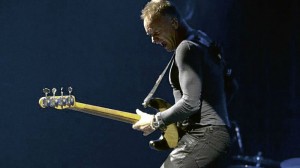Sting: Listen to the lyrics
A high school buddy kept pestering us for tickets to Sting’s Dec. 9 concert at Smart Araneta Coliseum. When we told him via SMS that even the media might have a hard time getting in because the show was practically sold out, he replied in mock frustration: “I hope Sting plays only three songs and spends the rest of the night lecturing about climate change!”
We laughed, although we surmised that many others were feeling as disappointed as our friend. It’s been 18 years since Sting last performed in Manila and, according to Ticketnet staff, only general admission tickets are left for the gig.
That’s too far from the stage but certainly affordable at P1,030 each. So, we’ll probably convince our friend to join us at the bleachers—where lots of rabid fans would surely have fun tripping on the soundtrack of their youth.
There are two major phases in Sting’s remarkable music career: first, his stint with The Police from 1978-1983; and second, his solo work from 1985 to the present. We are partial to his years with The Police, although his solo output is at par, if not more expansive, in form and content.
Distinct appeal
Article continues after this advertisementThe Police was a trio—guitarist Andy Summers, drummer Stewart Copeland and bassist-frontman Sting—formed in London in 1977, right smack in the middle of the punk rock explosion. That explained the band’s aggressive sound in its early years, but which was made more accessible by its incorporation of reggae and pop in the songs.
Article continues after this advertisementThere was a distinct appeal in the way they sounded—Sting’s energizing, high-pitched vocals, Copeland’s relentless percussion rhythms, and Summers’ snaking guitar riffs.
The group had already released three albums—“ Outlandos d’Amour” (1978), “Reggatta de Blanc” (1979) and “Zenyatta Mondatta (1980)”—when we first heard one of its hits, “De Do Do Do, De Da Da Da,” on FM radio station 99.5 RT.
We thought, like most of our schoolmates then, that it sounded silly, even as we were hooked on its dance beat.
But Sting himself, in an interview with Rolling Stone magazine in 1985, countered people’s notion of the song: “I was trying to make an intellectual point about how the simple can be so powerful. Why are our favorite songs ‘Da Doo Ron Ron’ and ‘Do Wah Diddy Diddy’? In the song, I tried to address that issue. But everyone said, ‘This is bullshit, child’s play.’ Listen to the lyrics. I’m going to remake it and put more emphasis on what I was talking about.”
Teen concerns
We couldn’t care less, anyway, because soon after hearing “Dee Do Do Do,” a lot of other Police songs grabbed our attention because they captured our teenage concerns and preoccupations in less than five minutes each: “So Lonely,” “Can’t Stand Losing You,” “Roxanne,” “Message in a Bottle,” “Don’t Stand So Close To Me,” “Driven To Tears,” “Every Little Thing She Does Is Magic.”
When Ninoy Aquino was assassinated in 1983, there was one Police tune, released two years earlier, that found relevance whenever our college gang got together: “Spirits in the Material World” with its lyrics, “Our so-called leaders speak/With words they try to jail you/They subjugate the meek/But it’s the rhetoric of failure.”
Not long after its “Synchronicity” album came out, also in 1983, The Police became the most important band in our life. The songs’ themes and meanings were always discussed whenever they were played at the campus parking lot: the psychological views in “King of Pain,” “Mother,” “Wrapped Around Your Finger” and the band’s biggest hit, “Every Breath You Take,” not to mention “Synchronicity I” and “II” and their references to Carl Jung and theories on the nature of coincidence.
Heavy stuff
Pretty heavy stuff for the ordinary rocker, but we were impressed even more when Sting started releasing solo albums after The Police broke up. The first two, “The Dream of the Blue Turtles” (1985) and “…Nothing Like the Sun” (1987), marked a return to his early musical influences, jazz and classical, while freely exploring songs with themes both serious (“Russians,” “They Dance Alone”) as well as lighthearted (“If You Love Somebody, Set Them Free,” “Englishman in New York”).
After the demigods (Dylan, The Beatles) of the ’60s and the rest of the rock stars of the ’70s, Sting’s work in the late ’80s as a solo artist represented a period when music, more than any art form, provided inspiration and solace in good and bad times.
The British singer-songwriter’s Big Dome concert, part of his ongoing “Back to Bass” tour, will do away with orchestras or big band setups—relying instead on a tight, three-man backup: Dominic Miller (guitar), David Sancious (keyboards) and Vinnie Colaiuta (drums), plus Peter Tickell (electric fiddle) and Jo Lawry (vocals).
A sample setlist of this tour, posted online from a March 19 show in London, shows that Sting will be playing 22 songs—at least five from The Police years and the rest from his solo work.
Watching it from the farthest section of Smart Araneta might still be more exciting than merely listening to our idol’s songs on CD the whole night.
